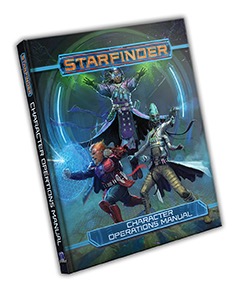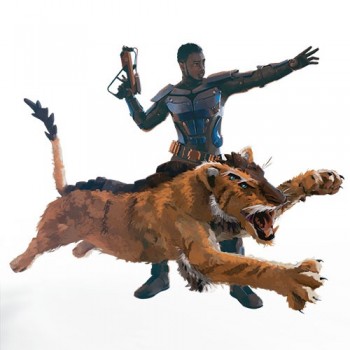Exploring Character in Starfinder
 One great feature of the class designs in the Starfinder Core Rulebook is that each class has a variety of choices, allowing for distinct builds that can suit a variety of play styles. You can build a Mechanic or Technomancer that is either a weak combat-avoiding technician or a combat-ready armored cyber-warrior, for example. This initial diversity has allowed for many permutations on the basic character options, so right out of the gate there’s little chance of players feeling like they’ve explored everything their characters can do. Over its first couple of years, the expansions have focused on new playable races (across three Alien Archive volumes!) and equipment (in an entire Armory volume), but there have been fewer additional options by comparison to modify the core characters.
One great feature of the class designs in the Starfinder Core Rulebook is that each class has a variety of choices, allowing for distinct builds that can suit a variety of play styles. You can build a Mechanic or Technomancer that is either a weak combat-avoiding technician or a combat-ready armored cyber-warrior, for example. This initial diversity has allowed for many permutations on the basic character options, so right out of the gate there’s little chance of players feeling like they’ve explored everything their characters can do. Over its first couple of years, the expansions have focused on new playable races (across three Alien Archive volumes!) and equipment (in an entire Armory volume), but there have been fewer additional options by comparison to modify the core characters.
The release of Starfinder‘s most recent rules supplement, the Character Operations Manual (Paizo, Amazon), definitely helps remedy that situation. Like Pathfinder‘s Advanced Player’s Guide, this is really the volume that establishes the ability to deeply customize characters … a hallmark of what made the Pathfinder RPG distinctive. In addition to three completely new classes, the Character Operations Manual presents more Themes, alternate racial traits for core races and Pathfinder legacy races, Archetypes that provide alternate class features, feats, equipment (including shields), spells, new starship combat rules, and an entirely new downtime system mechanic.
Themes are general background concepts for the character, which are independent of class. Any class of character can be an Outlaw or Scholar from the Core Rulebook, for example. This choice provides an attribute increase and a skill bonus based on the choice, as well as a lowered DC on certain knowledge checks based on your background expertise. In addition, each Theme gets new unique abilities at 6th, 12, and 18th level. The new options are: Athlete, Grifter, Guard, Law Officer, Noble Scion, Sensate, and Street Rat. You can read about them individually online at the Archives of Nethys.
The new optional racial traits can replace existing ones. An android can choose to have extra cybernetics instead of an armor upgrade slot or a ysoki can choose to be Scrappy (gaining extra hit points and a melee bonus when hurt) in place of the race’s normal Moxie ability or a halfling can be particularly adept at reloading needler weapons (in place of being sure-footed). Some feats similarly are tied to race, such as the Arm Extensions feat that Androids can take to gain the ability to extend their arms for reach weapons or to help climb or lower themselves. The Helpful Telepath feat allows a bug-like shirren to gain better benefit from helpful actions like Aid Another, Covering Fire, or Harrying Fire, taking existing abilities and making them work together in innovative new ways.
One of the major features of the Character Operations Manual are the three new classes: the Biohacker, the Vanguard, and the Witchwarper. The Biohacker is a science-based character who can rapidly create serums to either boost allies or inhibit enemies. The Vanguard is a warrior who wields the entropic power of change and decay as a weapon, able to expend an Entropic Pool of points to increase speed or boost damage and unlock other abilities. The Witchwarper is able to manipulate reality itself, pulling in traits from other dimensions and cast spells to throw off enemies.
In addition to the new classes, the Archetypes allow characters to swap out some class abilities to gain a different flavor of abilities, usable with any class. So the Android Abolitionist archetype can be used by either a Vanguard or a Mechanic, and both would give up some of their base class abilities to gain the Cunning Liberator ability at 4th level, and then other abilities at 9th and 18th level. Some archetypes involve more abilities than others. The Free Trader archetype has only one alternate ability, provided at 2nd level, for example.
The rules adding shields to the game is a nice touch, and they’ve retroactively provided the proficiency feat to several appropriate core classes. The additional rules for starship combat add two new roles, the Chief Mate and the Magic Officer, providing more options for physically-oriented or mystic characters during starship combat encounters. The Downtime activities system provides a range of activities that can be used to fill the days between adventures or during space travel between worlds, such as carousing, performing combat drills, researching, or retraining.
 The Character Operations Manual isn’t the only recent supplement that Starfinder fans will find useful in gaining more options for character creation and development. In addition to the many playable races in the Alien Archive 3 (Paizo, Amazon), and of course the various possible enemies, it contains the long-awaited rules for incorporating Creature Companions into the game. As someone who frequently runs games with my two kids and sometimes their friends, this is a crucial system to have within the game. The upcoming Alien Archive 3 Pawn Box (Paizo, Amazon) will include pawns for these various creature companions, including original artwork that wasn’t present in the book itself. You can learn some more on the creature companions on this video from Paizo.
The Character Operations Manual isn’t the only recent supplement that Starfinder fans will find useful in gaining more options for character creation and development. In addition to the many playable races in the Alien Archive 3 (Paizo, Amazon), and of course the various possible enemies, it contains the long-awaited rules for incorporating Creature Companions into the game. As someone who frequently runs games with my two kids and sometimes their friends, this is a crucial system to have within the game. The upcoming Alien Archive 3 Pawn Box (Paizo, Amazon) will include pawns for these various creature companions, including original artwork that wasn’t present in the book itself. You can learn some more on the creature companions on this video from Paizo.
A major upcoming accessory is the Deck of Many Worlds (Paizo, Amazon), slated for release in mid-January. This amazing deck has a variety of exotic planets, along with cards that modify the planet including unique features, sentient aliens, and alien threats. Using a handful of cards, you can create a random world that has plenty of plot hooks. Those interested in seeing more about how the Deck of Many Worlds works can check out the Paizo.com blog post or this video from Paizo’s Starfinder Wednesday series. Even if you don’t play Starfinder itself, this deck would be useful in providing creative brainstorming ideas for writers or gamers who create new worlds to explore.
The major setting emphasis of Starfinder since its release has been on the central setting of the Pact Worlds, but in late March the setting materials expand with Starfinder Near Space (Paizo, Amazon). In addition to information on various individual Near Space worlds, this resource looks like it will provide the first detailed information about the Veskarium, the home system of the lizardlike warrior Vesk that are one of Starfinder’s core races. And to get into Near Space, you may want to look at the rules forthcoming in the summer release of the Starship Operations Manual (Paizo, Amazon).
I’m really enjoying all this Starfinder coverage, Andrew. I finally bought the core rulebook (and the Beginner Box) last year after all your articles, and then went a little crazy with all the supplements.
Thanks for getting me started on another obsessive hobby!